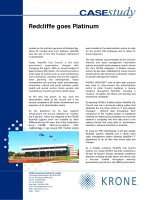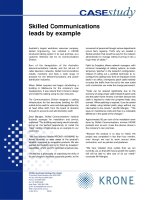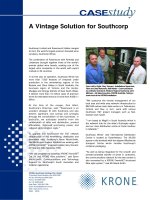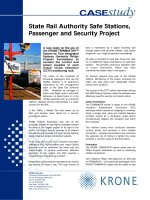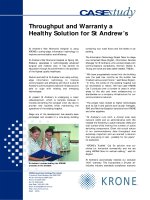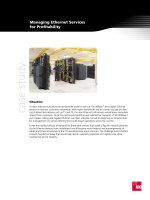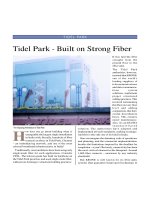Tài liệu Case Study—Speaking Truth to Power ppt
Bạn đang xem bản rút gọn của tài liệu. Xem và tải ngay bản đầy đủ của tài liệu tại đây (126.92 KB, 5 trang )
CASE STUDY Speaking Truth to Power www.englundpmc.com Page 1 of 5
Case Study—Speaking Truth to Power
The Speaking Truth to Power process is illustrated in this case study.
Start at the top and move clockwise.
A project manager at a high tech company sensed a big problem.
There was no process in place to manage hundreds of technical issues
that had been identified within a newly developed computer
architecture…and products were now being developed based upon this
problem-laden architecture. Toni knew the news was bad and getting
worse, but she had no more authority than anyone else to do anything
about those issues. The complexity of the situation was different than
anything else this organization had experienced before. All variables
were changing: markets, products, technology, people, organization,
and size. No one person was directly in charge. No one was putting in
the effort to correct what looked like a massive problem.
However, there was something different about this person—she was
willing to speak truth to power. Project leaders are closest to the
action in most organizations. While that makes them knowledgeable
about what is going on and what should be done to achieve project
success, unfortunately, they often do not possess the resources,
political clout, or approval to do those things. And the people in power
are not always open to hearing the truth. This happens for any
number of reasons, such as pressure from shareholders, a drive to
© 2007 Randall L. Englund
CASE STUDY Speaking Truth to Power www.englundpmc.com Page 2 of 5
meet an out-of-alignment measurement system, turf battles, or
insufficient knowledge about the project management process. Even
worse, the messenger may get proverbially “shot” for delivering the
“truth” (bad news) to those in “power”—telling the truth can have
negative consequences to the teller.
Toni took the initiative to define the truth. The issues reflected big
gaps, errors, or undefined paths in the new computer architecture,
issues so significant that new product development was being delayed
in multiple areas. Several different product lines would be built upon
this platform. If the issues were not resolved rationally, immediate
design decisions would have to be made on multiple projects that
might compromise or severely limit future functionality options in the
products being developed. Architects argued for the purity and
integrity of the architecture. Implementers wanted pragmatic
solutions that leveraged the work completed to date. The problem
was not getting solved—concrete closure actions were not getting
taken. The congenial but functionally separated environment was
potentially “toxic” for anyone stepping up to take charge.
She was one among dozens of project managers depending upon the
new architecture. Overall, Toni took it upon herself to cause action.
She created a compelling picture of why action was required, what
needed to be done, how to resolve the issues, and what the results
would be. Here are steps she took:
She identified the functional managers whose business was
impacted by the issues and asked them to get together for a
discussion. These upper managers were clearly frustrated by the
issues and concerned about getting their projects completed on
time. They had no spare resources to resolve issues that they
believed other people should be working on. Her personal invitation
to attend a meeting with peer managers to address important and
urgent issues, or else be stuck with what others decided, made it
compelling for them to show up at the meeting.
To deliver the truth, she put together a presentation that clearly
stated the nature of the issues and catastrophic impact on all
business areas. In the meeting with R&D managers from across
the organization who were responsible for developing various pieces
of the computer platform, she articulated the issues with amazing
alacrity. Yet she did not overwhelm them with details—they knew
enough to fill in the blanks with the pictures she presented. The
consequences of inaction were delays in time to market, duplication
CASE STUDY Speaking Truth to Power www.englundpmc.com Page 3 of 5
and rework of effort, frustrated engineers, high costs, bad publicity,
and unfavorable attention from unhappy executives. She spoke a
language they all understood extremely well.
In this presentation, she proposed that each business ante up key
engineers to meet in study groups that would research the options
for resolving the architectural issues and propose solutions. People
in all project areas would then need to review the proposals and
agree to adopt them. This work would have to take place
concurrently with development efforts underway. (NOTE: Although
not actually required in this case, many times it takes bringing in a
trusted outsider, such as somebody in another organization who
solved a similar problem, or a consultant, to convince people that
such drastic action is required.)
What made Toni able to take on such a strong role in a very sensitive
situation? Her actions were driven by choosing to exercise personal
strengths. Her passion and belief in a very different future state being
possible provided courage and energy to take on this difficult task.
And she used savvy and sensitive communication skills to be credible,
trusted, and ultimately listened to:
• Through words and actions she made it clear that her sole
motivation was accountability for success of the program. It was
clear that she had no hidden agenda or desire for personal gain—
just relief from the frustration she was experiencing. Her
outspoken manner diffused any possible resistance by making it
clear, through her choice of words up front and throughout, that
she was not after personal glory or power plays but just wanted to
make the program successful. None of this was a surprise to the
attendees because she had conducted one-on-one discussions with
each manager in advance of the meeting.
• She pointed out the pain that could be felt by each person. She
had the ability to design a process that could lead to changes, and
she linked the pain and change efforts directly to needs of the
business.
• By reflecting and drawing upon previous experiences, she
articulated the current reality and defined the steps needed for the
change. Fortunately, she had completed a number of previous
projects quite successfully. She was technically competent and
could understand the difficult nature of the problems being
encountered. Her carefully chosen words addressed different
CASE STUDY Speaking Truth to Power www.englundpmc.com Page 4 of 5
perspectives; that is, she talked broad picture with upper managers
and technical issues with engineers. She consistently demonstrated
the values, beliefs, and contribution that this effort would bring to
the organization.
• She asked for their support. The goal of the meeting was to get
explicit commitment from all attendees that they and their
organization would participate in this program. This was not just
another meeting to talk about the issues; it was a call to action.
Toni’s thorough plan, reinforced by inputs from other people around
the organization, convinced this council of upper managers to get on
board as a guiding coalition. The plan first requested these managers
to set constraints and define priorities. It then described how cross-
organizational teams of engineers would be assigned full time to
specific modules or areas within the architecture. Approval would
come from all other teams reviewing, commenting, and voting on
proposals. Fears subsided as concerns about priorities, content,
process, oversight, approvals, and implementation were addressed.
In the end, they asked Toni to lead the new program.
Believing in the program, she agreed to get it going. She became the
leader, the guiding vision, and the workhorse. She also planned from
the beginning to go “out of business” as a revolutionary. Toni went to
the program management department and requested a program
manager. The initial conversation with Toni revealed many negative
expressions, but the program manager had a sense to persevere and
later came to realize the negativity came only out of Toni’s frustration
with the current realities. The program manager came on board and
gradually took over to coordinate the massive cross-organizational
efforts to execute this plan. After successfully completing the
tumultuous first phase, she guided the program team through a
retrospective analysis, saw that progress was proceeding on the right
path, went back to managing her own project full time, and got
promoted. She continued taking on new development efforts within
the company.
Her impact extended beyond that critical program. The program team
became quite competent on the new process that it had invented and
then refined about how to identify and resolve architectural issues. It
was significant to observe how the management anxiety initially
present around the complexity and far-reaching nature of the “truth”
was upsetting to those in “power” and gradually subsided and mostly
CASE STUDY Speaking Truth to Power www.englundpmc.com Page 5 of 5
disappeared over the course of the program. Credit goes not only to
the engineers doing the work but also to the program management
approach that was applied. All this became possible because one
person was wiling to risk her career and speak up. Resolving those
architectural issues was at the heart of the huge success subsequently
enjoyed by the company in the computer business. Management
supported a huge celebration to recognize the achievements of many
that were initiated by the power of one.
Later the program manager sought out this person as a mentor as he
was so impressed by her abilities in getting things done within a
convoluted organization. He wanted to know how she managed to
exercise voice with power and short-cut a path to cultural distortion.
One question was about improving judgment. She suggested
observing judgmental situations—make your own call as difficult
decisions come up and observe how those in power make the same
call. Compare their actions with yours as a way to learn to make
better decisions from the masters. Seek to understand their thought
processes; probe into the reasons they act as they do. Her feedback
on this and other topics was invaluable and long lasting. Later in a
different job at corporate the program manager was able to
reciprocate and provide her with advice on a project submittal.
Take aways:
• Act from personal strengths, such as expert, visionary, or process
owner.
• Develop a clear, convincing, and compelling message and make it
visible to others.
• Use your passion that comes from deep values and beliefs about
the work (if these are not present, then find a different program to
work on).
• Be accountable for success of the organization and ask others to do
the same.
• Get explicit commitments from people to support the goals of the
program; then they are more likely to follow through.
• Take action, first to articulate the needs, then to help others
understand the change, and finally to get the job done, following a
plan.
• Tap the energy that comes from the courage of your
convictions…and from the preparation steps outlined above.


